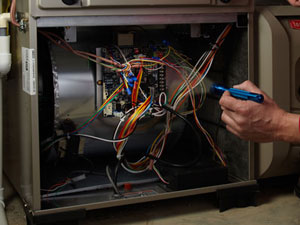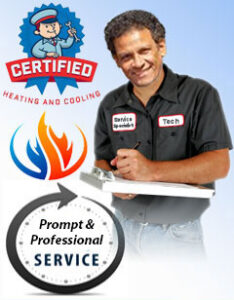 Here’s our electric furnace repair guide to help you fix or diagnose a malfunctioning electric furnace yourself. Electric furnaces are less efficient & more costly to run than gas or oil furnaces, radiators or heat pumps, but safer to operate & less costly to install. In warmer places like Florida it’s a good option since heat is needed mush less often. But if you’re in New York or most other parts of the country where it really gets cold, having your furnace suddenly stop heating can be an emergency. There’s several fixes that most homeowners can figure out themselves without having to call the pros. Our list also includes items for more experienced do it yourselfers.
Here’s our electric furnace repair guide to help you fix or diagnose a malfunctioning electric furnace yourself. Electric furnaces are less efficient & more costly to run than gas or oil furnaces, radiators or heat pumps, but safer to operate & less costly to install. In warmer places like Florida it’s a good option since heat is needed mush less often. But if you’re in New York or most other parts of the country where it really gets cold, having your furnace suddenly stop heating can be an emergency. There’s several fixes that most homeowners can figure out themselves without having to call the pros. Our list also includes items for more experienced do it yourselfers.
Be careful not to perform any electric furnace repairs that will void a warranty. Always make sure to shut off power to the system when removing any parts, including the air filter.
Knowing how to use any $25 multimeter will enable you to do more extensive electric furnace repair & troubleshooting by being able to test several parts for power to see if the part itself needs replacement, such as the thermostat, breaker, blower motor, limit switch, fuse, relay, shut off switches, control board & transformer. The general concept is to test each component in the system to see at which point the power is interrupted. If power is reaching the component but not passing through it then it likely needs replacement.
Even without a multimeter but with just a flashlight you can visually inspect all the wiring & electrical components to see if anything is burned or melted. It’s not uncommon especially on older systems that electronic parts just burn out after many years of operation. For instance, if you see a burned control board, you may be able to replace it by turning off the system power, pulling the part (always take pictures of the wire connections first before removing), checking the part number & ordering it online. Alot of these parts can be found on Ebay. Carefully replace the new part by making sure you have all the wires properly put back according to the pictures you took before removing it. Restore power to the system & perform a test only after the part is fully installed.
Furnace Does Not Turn On
Furnace Turns On But Fan Doesn’t Run or Blows Weak
Furnace Turns On But Blows Cold Air
Furnace Runs But Doesn’t Heat Enough
Furnace Heats But Blower Runs Continuously
Furnace Doesn’t Heat At All & Blower Runs Continuously
Furnace Cycles On & Off Often
Furnace or Duct Work Is Noisy
Furnace Does Not Turn On
• Thermostat not set to heat: Make sure the thermostat is set to heat. See if increasing the temperature five degrees over the room temp turns on heat within a few minutes.
• Thermostat has low or dead battery: Check the display if it’s dim, off or if the time/date are incorrect, indicating a low battery (some thermostats are wired to electrical so this wouldn’t apply). If so, open the thermostat to replace the battery & also check the the battery contacts which could be dirty or corroded & need cleaning. Clean with a cotton swab & alcohol.
• Thermostat wiring, faulty, dirty or corroded: Open the thermostat to see if there’s any obvious dirt or corrosion to the wiring. See the below video to test the wiring.
• Thermostat improperly programmed: Check the manual for programming instructions.
• Thermostat has malfunctioned & needs replacement: See the video below to test your thermostat. Thermostats can eventually fail & need replacement, it’s not too difficult to do yourself.
• Thermostat not properly located to get accurate reading: An improperly located thermostat, such as in direct sunlight, will give inaccurate readings & not turn the system on & off when needed. You may need a pro to relocate it.
• Breaker panel switch for furnace has tripped to off: Sometimes a breaker can be caused to shut off by an outage or surge. Check the house circuit breaker panel, see if the switch for the furnace is on. If it’s off turn it all the way to off then to on. Do it a few times to make sure it stays in on position, then wait 5 minutes & see if the heat comes on, if not check the fuse. A tripped breaker could be a one time occurance but if it keeps happening you will need an electrician. There is some circuit breaker testing you can do with a multimeter to see if the breaker itself has gone bad (see this video).
• Furnace has a burned out fuse: If breaker switch is already on then turn it off & check if there’s a fuse on or inside the furnace which is burned out & needs replacement.
• Furnace has a shut off switch that’s switched off: Some furnaces have a power switch on or nearby the furnace, it could be a wall switch just like a light switch.
• Furnace door has a safety switch that needs to be reset or needs replacement: Some furnaces have a safety switch on the furnace door which will prevent the fan & burner from running if off. In rare instance on an old unit it’s possible the switch has malfunctioned & needs replacement. You would need to check the connection with a multimeter to confirm it’s working.
• Blower motor has a safety switch that needs to be reset: Some blower motors have a safety switch which needs to be reset, if so press it, if the system doesn’t turn on try again after 30 minutes, the motor may need to cool.
• Blower motor failure: Possibly the blower motor could fail & need replacement. It would need to be tested with a multimeter to see if power is reaching the motor. If power is there but the motor isn’t running & you’ve already checked for a safety switch, then the motor will need replacement.
• Failed Limit Switch: The limit switch prevents the furnace from overheating & if it fails the system may not run.
• Failed Sequencer: The sequencer turns heating elements on and off in a sequence so that they’re not all on at once which can overload the breaker. If the sequencer fails it can cause the furnace to overheat or trip the breaker.
Furnace Turns On But Fan Doesn’t Run or Blows Weak
• Broken or loose blower belt: Check if the belt is not broken or needs tightening. Turn off power, remove access panel, check belt number & get a replacement if needed. Put one end of belt on the small pulley first then rotate the other pulley while slipping the belt on that end. You may need to adjust belt tension so that it moves no more than an inch when pressing on it.
• Blower motor failure: The furnace will usually not run if the motor has failed, though it is possible. It could also run only at partial speed if it’s failing, causing the air to blow weak. First check the motor for a safety switch. Then test it with a multimeter for power, it will need replacement if it’s getting power & not running.
• Dirty blower wheel: A dirty blower wheel caused by infrequent filter changing will reduce air flow, increase electricity use & cause other problems. Clean the wheel & change filters regularly.
• Faulty electronic parts: A fan not running can be caused by any of several electronic parts being faulty, namely the thermostat, fan relay, fan blower motor, furnace control board or transformer. Check the electronic parts with a multimeter or just a flashlight to look for any burned or melted parts or wires.
Furnace Turns On But Blows Cold Air
• Faulty Electronic Parts: If any of these parts fail it can cause the air to blow cold – heat sequencer, limit control, control board, heating element. Check the electronic parts with a multimeter or just a flashlight to look for any burned or melted parts or wires. You may luckily find the culprit & successfully complete your electric furnace repair.
Furnace Runs But Doesn’t Heat Enough
• Furnace is too small for space: If, to your knowledge, the furnace has never adequately heated there is the possibility that the furnace is not adequately sized for the space. There is a large range of furnace sizes based on BTU’s & how many square feet a furnace can heat. You just may need a more powerful system. Click here to check the required size you need.
• Thermostat: Make sure the thermostat is set at least 5 degrees above room temperature. There could be an another issue with the thermostat. A thermostat issue could cause a furnace to not heat at all, not heat enough, or to turn on & off frequently. The problem could be the battery, battery contacts, wiring, a faulty thermostat or improper placement. If the thermostat is not situated centrally & away from direct sunlight it could give an inaccurate reading & not be turning the system on when needed. You may need a pro to relocate the thermostat. See the thermostat section covered above for more details on diagnosing the thermostat.
• Clogged filter: The easiest & cheapest electric furnace repair you can do yourself is to change a dirty filter, but it should be done regularly before it gets too dirty & causes other problems. Filters need replacement every 1-3 months. A dirty filter restricts air flow, reduces efficiency by causing the air handler to run more & increase electric usage. It can damage the limit switch causing it to shut off too soon.
• Dirty blower wheel: Lack of regular filter replacement could result in excess dirt buildup on the blower wheel, which will cause it to turn less freely & reduce the system efficiency, using more electricity, eventually requiring expensive repairs. Turn the system off, clean the wheel & replace filters regularly.
• Loose Blower Belt: A loose belt can cause the blower wheel to turn less & not circulate the warm air adequately
• Vents are closed or obstructed: Check that room vents are open, clean & unobstructed, allowing air to freely circulate.
• Faulty Heating Element: Check that all the heating elements are working. A faulty heating element or fan motor can result in not enough heat.
Furnace Heats But Blower Runs Continuously
• Thermostat fan switch may be set to on instead of auto, which makes the fan run continuously. A Faulty relay can also cause this.
Furnace Doesn’t Heat At All & Blower Runs Continuously
• Limit switch needs replacement or adjustment
Furnace Cycles On & Off Often
• Clogged filter: Replacing a clogged filter is the easiest electric furnace repair you can do. Filters need replacement every 1-3 months. A dirty filter restricts air flow, reduces efficiency by causing the air handler to run more & increase electric usage. It can damage the limit switch causing it to shut off too soon. Simply replacing the filter may solve the problem.
• Dirty blower wheel: Lack of regular filter replacement could result in excess dirt buildup on the blower wheel, which will cause it to turn less freely & reduce the system efficiency, using more electricity, eventually requiring expensive repairs. Turn the system off, clean the wheel & replace filters regularly.
• Blower motor or blower wheel needs lubrication to turn more freely.
• Faulty thermostat
• Vents are closed or obstructed: Check that room vents are open, clean & unobstructed, allowing air to freely circulate.
Furnace or Duct Work Is Noisy:
• Noises are caused by a loose panel, loose parts, loose belt, belt, motor or blower needs lube
• Squealing: Loose or broken blower belt
• Rattling: Loose screws on panels
• Squeaking: Set screw on blower fan wheel needs tightening
• Grinding: Worn bearings
• Pinging: Normal sound caused by ductwork expanding & contracting from heating or cooling
Goods luck with your electric furnace repair, if you need an HVAC professional in Brooklyn NY contact us at 718-690-3718
Our Gas Furnace Repair Guide








